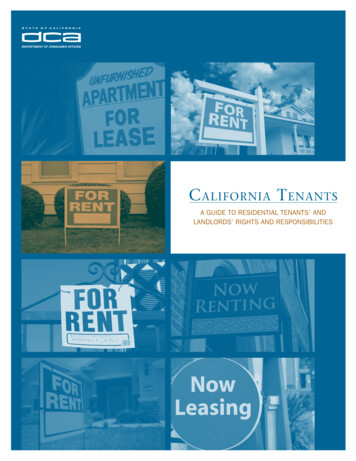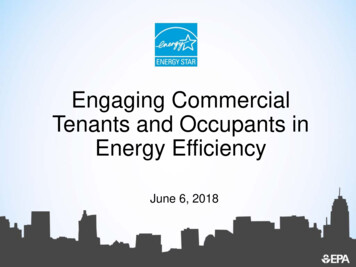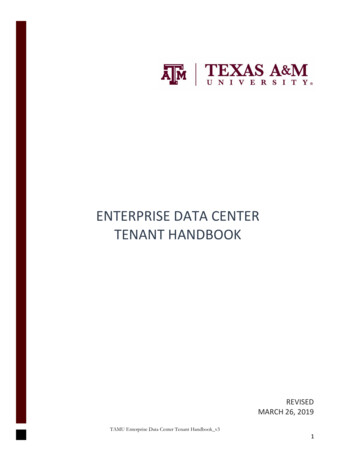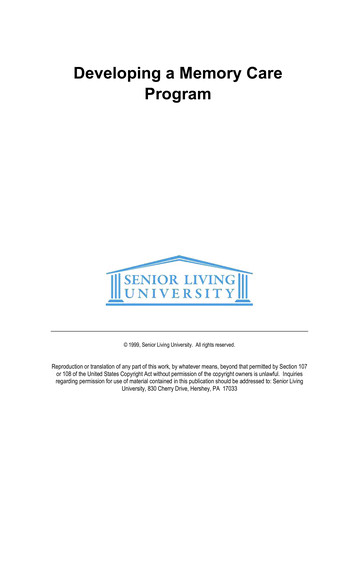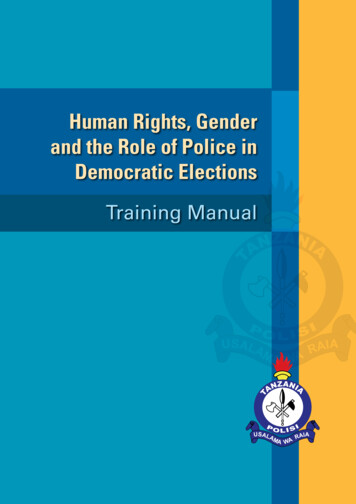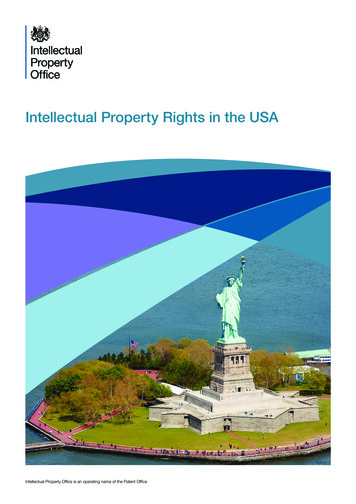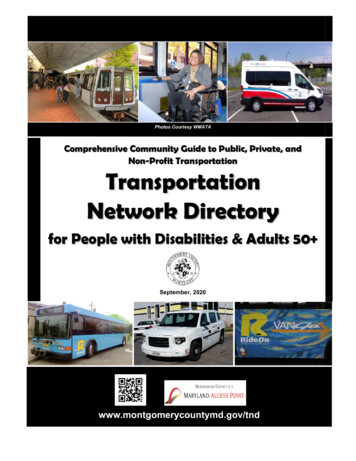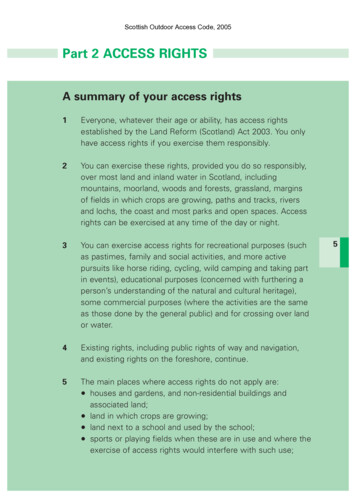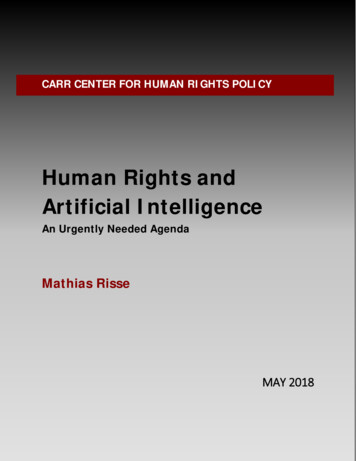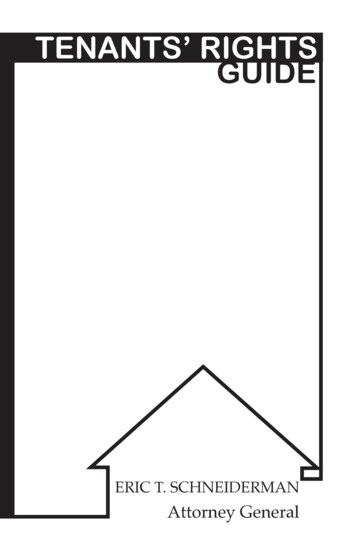
Transcription
TENANTS’ RIGHTSGUIDEERIC T. SCHNEIDERMANAttorney General
ERIC T. SCHNEIDERMANAttorney GeneralDear New Yorker:The contract between a tenant and landlord,whether it is based on a written lease or ahandshake, is one of the most common and important deals thatare made across our state. It defines how renters will enjoy theirhomes, how owners will maintain their property, it can affect aneighborhood’s stability.That’s why it’s important that everyone understands their rightsand responsibilities under the law. In New York State, there areseveral different laws governing this relationship, and they canbe different depending upon the county or town you live in. Thisbooklet explains many of the laws tenants need to know andprovides resources for where you can find more information aboutlandlord and tenant issues.As Attorney General, it’s my job to make sure the rights of allNew Yorkers are protected. Whether the issue involves civilrights or consumer affairs, healthcare or investment fraud — myoffice may be able to help. Please visit our website:www.ag.ny.govor call our hotline:800-771-7755to learn more about how we can help.Sincerely,Eric T. Schneiderman
Table Of ContentsIntroduction1Types Of Housing1Leases3Rent6Lease Succession Or Termination10Habitability And Repairs17Safety20Utility Services23Tenants’ Personal Protections24Finding An Apartment28Resources29
INTRODUCTIONThe rights of residential tenants in New York State are protected by avariety of federal, state and local laws. In addition, areas of the Statesubject to rent stabilization, rent control or other rent regulation mayhave special rules that apply to certain dwellings. Tenants are advised toconsult a lawyer regarding particular situations of concern.I. TYPES OF HOUSINGRent control and rent stabilization are the two types of rent regulationin New York State. An apartment not subject to these regulations isconsidered “unregulated.” An individual tenant’s rights will depend,in part, upon which regulations apply, although some apartments mayfall under more than one category. While tenants in rent regulated orgovernment subsidized apartments have special rights, many rules andlaws apply to both unregulated and regulated apartments. To find outwhether an apartment is regulated, contact the New York State Division of Housing and Community Renewal.Rent Regulated HousingRent ControlRent control limits the rent an owner may charge for an apartmentand restricts the right of the owner to evict tenants. The rent controlprogram applies to residential buildings constructed before February,1947 in municipalities that have not declared an end to the postwarrental housing emergency. Rent control is still in effect in New YorkCity and parts of Albany, Erie, Nassau, Rensselaer, Schenectady, andWestchester counties.In order for an apartment to be under rent control, the tenant or thetenant’s lawful successor (such as a family member, spouse, or adultlifetime partner) must have been living there continuously since beforeJuly 1, 1971. When a rent controlled apartment is vacated in New YorkCity or most other localities, it becomes rent stabilized or completely removed from regulation. In New York City, each rent controlledapartment has a maximum base rent that is adjusted every two years1
to reflect changes in operating costs. Tenants may challenge increases ifthe rent being charged by the landlord exceeds the legal regulated rent,the building has housing code violations, the owner’s expenses do notwarrant an increase, or the owner is not maintaining essential services.Rent StabilizationIn New York City, apartments are generally under rent stabilization ifthey are: In buildings of six or more units built between February 1, 1947and December 31, 1973; In buildings built before February 1, 1947, with tenants whomoved in after June 30, 1971; In buildings with three or more apartments constructed or extensively renovated on or after January 1, 1974 with special taxbenefits.Outside New York City, rent stabilized apartments are generally foundin buildings with six or more apartments that were built before January1, 1974.Local Rent Guidelines Boards in New York City, Nassau, Rocklandand Westchester counties set maximum rates for rent increases once ayear which are effective for one or two year leases beginning on or afterOctober 1 each year.Tenants in rent stabilized apartments are entitled to required essential services and lease renewals, and may not be evicted except on grounds allowedby law. Any apartment with a monthly rent of 2,500 or more per monthbecomes deregulated when it becomes vacant. Occupied apartments maybe deregulated when the legal regulated r ent for the apartment reaches 2,500 or more and the apartment’s occupants have a total annual incomein excess of 200,000 per year in each of the two years preceding the deregulation. Total annual income is the sum of the annual incomes of allpersons (other than subtenants) who occupy the apartment as their primary residence on a non- temporary basis. A tenant in a unit that becomesderegulated may be offered a rent at the prevailing market rate.Government-Financed HousingThe Mitchell-Lama housing program provides rental and cooperativehousing for middle-income tenants. For both state and city-sponsored2
Mitchell-Lama developments, tenants must meet eligibility requirements including income, family size and apartment size. Additionally,each development sets its own restrictions.Public Housing is a federally funded program in which state charteredauthorities develop and manage public housing developments, subjectto federal, state, and local laws and regulations. Tenants in public housing are entitled to an administrative grievance process administered bythe local housing authority before they may be evicted.The Section 8 Housing Assistance Payments program is a rent andmortgage subsidy program that assists eligible low-income or displacedfamilies, senior citizens and disabled persons in obtaining housing.Families receive a rental subsidy, known as a housing assistance payment, or a mortgage subsidy towards payments to purchase a home,equal to the difference between their share of the rent, (based on theirincome) and the approved rent or mortgage for the unit. Eligible families and individuals are subject to statutory income limits.Special Types of Housing Manufactured and mobile home parks’ owners and tenants aregoverned by Real Property Law § 233 (“Mobile Homeowner’s Bill ofRights”). The DHCR enforces compliance with this law. New York City loft owners and tenants are governed by Multiple Dwelling Law, Article 7-C, enforced by the New York City LoftBoard. New York City residential hotel owners and tenants are governedby the rent stabilization law, enforced by the DHCR.II. LEASESA lease is a contract between a landlord and a tenant, containing theterms and conditions of the rental. It cannot be changed while it is ineffect unless both parties agree. Leases for apartments which are notrent stabilized may be oral or written. To avoid disputes, the partiesmay wish to enter into a written agreement. A party must sign the leasein order to be bound by its terms. An oral lease for more than one yearcannot be legally enforced (General Obligations Law § 5-701).3
At a minimum, leases should identify the premises, specify the namesand addresses of the parties, the amount and due dates of the rent, theduration of the rental, the conditions of occupancy, and the rights andobligations of both parties. Except where the law provides otherwise, alandlord may rent on such terms and conditions as are agreed to by theparties. Any changes to the lease should be initialed by both parties.New York City rent stabilized tenants are entitled to receive from theirlandlords a fully executed copy of their signed lease within 30 days ofthe landlord’s receipt of the lease signed by the tenant. The lease’s beginning and ending dates must be stated. Rent stabilized tenants mustalso be given a rent stabilization lease rider, prepared by DHCR, whichsummarizes their rights under the law and provides specific information on how the rent was calculated.Lease ProvisionsLeases must use words with common and everyday meanings and mustbe clear and coherent. Sections of leases must be appropriately captioned and the print must be large enough to be read easily. (GeneralObligations Law § 5-702; NY C.P.L.R. § 4544.)The following lease provisions are void: Exempting landlords from liability for injuries to persons or property caused by the landlord’s negligence, or that of the landlord’semployees or agents (General Obligations Law § 5-321); Waiving the tenant’s right to a jury trial in any lawsuit brought byeither of the parties against the other for personal injury or property damage (Real Property Law§ 259-c); Requiring tenants to pledge their household furniture as securityfor rent (Real Property Law § 231).If a lease states that the landlord may recover attorney’s fees and costsincurred if a lawsuit arises, a tenant automatically has a reciprocal rightto recover those fees as well (Real Property Law § 234).If the court finds a lease or any lease clause to have been unconscionable at the time it was made, the court may refuse to enforce the leaseor the clause in question (Real Property Law § 235-c).4
Renewal LeasesFor non-rent regulated apartments, the landlord must agree to renewthe lease and a tenant may be subject to eviction at the end of thelease term. However, a lease may contain an automatic renewal clause.In such case, the landlord must give the tenant advance notice of theexistence of this clause between 15 and 30 days before the tenant isrequired to notify the landlord of an intention not to renew the lease.(General Obligations Law § 5-905).Rent stabilized tenants have a right to a one or two year renewal lease,which must be on the same terms and conditions as the prior lease, unless a change is mandated by a specific law or regulation. A landlord’sacceptance of a Section 8 subsidy is one such term which must be continued on a renewal lease. Landlords may refuse to renew a lease onlyunder certain enumerated circumstances, such as when the tenant isnot using the premises as a primary residence. For New York City rentstabilized tenants, the landlord must give written notice to the tenantof the right to renewal by mail or personal delivery not more than 150days and not less than 90 days before the existing lease expires.After the notice of renewal is given, the tenant has 60 days in whichto accept. If the tenant does not accept the renewal offer within theprescribed time, the landlord may refuse to renew the lease and seek toevict the tenant through court proceedings. If the tenant accepts therenewal offer, the landlord has 30 days to return the fully executed leaseto the tenant. Until returned to the tenant, the lease is not effective andtherefore the rent increase portion need not be paid.Month to Month TenantsRenters who do not have leases and pay rent on a monthly basis arecalled “month-to-month” tenants. In localities without rent regulation,tenants who stay past the end of a lease are treated as month-to-monthtenants if the landlord accepts their rent (Real Property Law § 232-c).A month-to-month tenancy outside New York City may be terminatedby either party by giving at least one month’s notice before the expiration of the tenancy. For example, if the landlord wants the tenantto move out by November 1 and the rent is due on the first of eachmonth, the landlord must give notice by September 30. In New York5
City, 30 days’ notice is required, rather than one month.Landlords do not need to explain why the tenancy is being terminated,they only need to provide notice that it is, and that refusal to vacatewill lead to eviction proceedings. Such notice does not automaticallyallow the landlord to evict the tenant. A landlord may raise the rent ofa month-to-month tenant with the consent of the tenant. If the tenantdoes not consent, however, the landlord can terminate the tenancy bygiving appropriate notice. (Real Property Law § 232-a and § 232-b).III. RENTRent ChargesWhen an apartment is not rent regulated, a landlord is free to chargeany rent agreed upon by the parties. If the apartment is subject to rentregulation, the initial rent and subsequent rent increases are set by law,and may be challenged by a tenant up to four years after the increasewent into effect.Rent Increases for Regulated Apartments — A landlord who pays fora substantial improvement to an occupied rent stabilized or rent controlled apartment may increase the rent for such apartment if the landlord obtained the written consent of the tenant to the increased rent.For a rent stabilized apartment, no order from the DHCR is requiredfor the rent increase. However, an order is required to increase the rentof a rent controlled apartment.Maximum rent increases for rent stabilized apartments are set each yearby the Rent Guidelines Board. In addition, landlords of rent stabilizedapartments may seek rent increases for certain types of building-widemajor capital improvements (MCI) that benefit all tenants, such as thereplacement of a boiler or the installation of new equipment. Rentsmay be increased in individual apartments for substantial increases indwelling space, new equipment, improvements or furnishings.In buildings that contain more than 35 apartments, the landlord cancollect a permanent rent increase equal to 1/60th of the cost of the Individual Apartment Improvements (IAI). In buildings that contain 35apartments or less, the landlord may collect a permanent rent increase6
equal to 1/40th of the cost of the IAI.For rent stabilized apartments in New York City, the rent adjustmentcollectible in any one year may not exceed six percent of the tenant’srent, although adjustments above that can be spread forward to futureyears. For all rent controlled or stabilized apartments outside New YorkCity, the permanent adjustment collectible in any one year may notexceed fifteen percent of the tenant’s rent.A landlord also may increase the rent because of hardship or increasedlabor costs, and in New York City rent controlled apartments, forchanges in the price of heating fuels.Exemptions —Tenants who are senior citizens (62 years or older) ordisabled may be granted certain exemptions from rent increases. Tenants may determine whether they qualify for a Senior Citizen RentIncrease Exemption (SCRIE) or a Disability Rent Increase Exemption(DRIE) by calling the DHCR’s Rent Info Line at (718) 739-6400.Receipts — Landlords must provide tenants with a written receiptwhen rent is paid in cash, a money order, and a cashier’s check or inany form other than the personal check of a tenant. Tenants payingrent by personal check may request, in writing, a rent receipt from thelandlord. The receipt must state the payment date, the amount, theperiod for which the rent was paid, and the apartment number. Thereceipt must be signed by the person receiving the payment and statehis or her title. (Real Property Law § 235-e).It is illegal to charge a prospective tenant a bonus– commonly called“key money”– above the lawful rent and security deposit, for preference in renting vacant apartment. Key money is not to be confusedwith fees that may be legally charged by a licensed real estate broker(Penal Law § 180.55).Rent OverchargesIn New York City and certain communities in Nassau, Rockland andWestchester counties where rent stabilization or rent control laws apply,the landlord may not charge more than the legal regulated rent. Underthe housing law, landlords must register each rent stabilized apartmentwith DHCR and provide tenants annually with a copy of the registra7
tion statement. Tenants may also get a copy of the rent history for theirapartment directly from DHCR. A tenant may only challenge rentsand collect any overcharges going back four years from the tenant’sfiling a complaint. The tenant is also entitled to recover interest, plusreasonable costs and attorney’s fees, for the overcharge proceeding.Generally, the penalty for a rent overcharge is the amount an ownercollected above the legal regulated rent, plus accrued interest. If theovercharge is willful, the landlord is liable for a penalty of three timesthe amount of the overcharge for two years prior to the filing of thecomplaint. The landlord has the burden of proving that the overchargewas not willful. Tenants who believe they are being overcharged shouldcontact DHCR.Rent Security DepositsVirtually all leases require tenants to give their landlords a security deposit; usually of one month’s rent. If a lease is renewed at a greateramount or the rent is increased during the term of the lease, the owneris permitted to collect additional money from the tenant in order tobring the security deposit up to the new monthly rent. Landlords, regardless of the number of units in the building, must treat the depositsas trust funds belonging to their tenants and they may not co-mingledeposits with their own money.Landlords of buildings with six or more apartments must put all security deposits in New York bank accounts earning interest at the prevailing rate. Each tenant must be informed in writing of the bank’s nameand address and the amount of the deposit. Landlords are entitled tocollect annual administrative expenses of one percent of the deposit. Allother interest earned on the deposits belongs to the tenants. Tenantsmust be given the option of having this interest paid to them annually,applied to rent, or paid at the end of the lease term. If the buildinghas fewer than six apartments, a landlord who voluntarily places thesecurity deposits in an interest bearing bank account must also followthese rules.For example: A tenant pays a security deposit of 1,000. The landlordplaces the deposit in an interest bearing bank account paying 1.5%. Atthe end of the year the account will have earned interest of 15.00. The8
tenant is entitled to 5.00 and the landlord may retain 10.00, 1% ofthe deposit, as an administrative fee.A landlord may use the security deposit as a reimbursement for any unpaid rent, or the reasonable cost of repairs beyond normal wear and tear,if the tenant damages the apartment. He or she must return the securitydeposit, less any lawful deduction, to the tenant at the end of the lease orwithin reasonable time thereafter, whether or not the tenant asks for itsreturn. To avoid any disputes, the tenant should thoroughly inspect theapartment with the landlord before moving in and document any preexisting conditions. Upon vacating, the tenant should leave the apartment in clean condition, removing all personal belongings and trashfrom the apartment, and making any minor repairs needed.Sale of BuildingIf the building is sold, the landlord must transfer all security depositsto the new owner within five days, or return the security deposits to thetenants. Landlords must notify the tenants, by registered or certifiedmail, of the name and address of the new owner.Purchasers of rent stabilized buildings are directly responsible totenants for the return of security deposits and any interest. This responsibility exists whether or not the new owner received the securitydeposits from the former landlord.Purchasers of rent controlled buildings or buildings containing sixor more apartments where tenants have written leases are directlyresponsible to tenants for the return of security deposits and interestin cases where the purchaser has “actual knowledge” of the securitydeposits. The law defines specifically when a new owner is deemed tohave “actual knowledge” of the security deposits (General ObligationsLaw, Article 7, Title1).When problems arise regarding security deposits, tenants should firsttry to resolve them with the landlord before taking other action. If adispute cannot be resolved, tenants may contact the nearest local officeof the Attorney General, listed at the end of this booklet.9
IV. LEASE SUCCESSION OR TERMINATIONSubletting or Assigning LeasesSubletting and assignment are methods of transferring the tenant’s legal interest in an apartment to another person. Here are the differencesbetween the two.SubletTo sublet means that the tenant is temporarily leaving the apartmentand therefore is transferring less than the entire interest in the apartment. A tenant who subleases an apartment is called the prime tenantand the person temporarily renting the premises is the subtenant.Tenants in buildings with four or more apartments have the right tosublet with the landlord’s advance consent. Any lease provision restricting a tenant’s right to sublease is void as a matter of public policy. Ifthe landlord consents to the sublet, the tenant remains liable to thelandlord for the obligations of the lease, including all future rent. If thelandlord denies the sublet on reasonable grounds, the tenant cannotsublet and the landlord is not required to release the tenant from thelease. If the landlord denies the sublet on unreasonable grounds, thetenant may sublet anyway. If a lawsuit results, the tenant may recovercourt costs and attorney’s fees if a judge rules that the landlord deniedthe sublet in bad faith (Real Property Law § 226-b(2)).These steps must be followed by tenants wishing to sublet:1. The tenant must send a written request to the landlord by certifiedmail, return-receipt requested. The request must contain the following information: (a) the length of the sublease; (b) the name,home and business address of the proposed subtenant; (c) the reason for subletting; (d) the tenant’s address during the sublet; (e)the written consent of any co-tenant or guarantor; (f ) a copy of theproposed sublease together with a copy of the tenant’s own lease,if available.2. Within ten days after the mailing of this request, the landlord mayask the tenant for additional information. Any request for additional information may not be unduly burdensome.3. Within 30 days after the mailing of the tenant’s request to subletor the additional information requested by the landlord, whichever10
is later, the landlord must send the tenant a notice of consent, orif consent is denied, the reasons for denial. A landlord’s failure tosend this written notice is considered consent to sublet (Real Property Law § 226-b(2)).Additional requirements limited to rent stabilized tenants: The rent charged to the subtenant cannot exceed the stabilized rent,plus a ten percent surcharge payable to the tenant for a furnishedsublet. Additionally, the stabilized rent payable to the owner, effective for the duration of the sublet only, may be increased by a“sublet allowance” equal to the vacancy allowance then in effect. Asubtenant who is overcharged may file a complaint with DHCR ormay sue the prime tenant in court to recover any overcharge plusinterest, attorneys’ fees, and treble damages where applicable (9NYCRR § 2525.6(e)). The prime tenant must establish that the apartment has-been maintained as a primary residence at all times, and must demonstrateintent to reoccupy it at the end of the sublet. The prime tenant, not the subtenant, retains the rights to a renewallease and any rights resulting from a co-op conversion. The term ofa sublease may extend beyond the term of the prime tenant’s lease.The tenant may not sublet for more than two years within anyfour year period (Real Property Law § 226-b; 9 NYCRR § 2525.6).Frequent or prolonged periods of subletting may be grounds for alandlord to seek possession of rent stabilized premises on the basisof non-primary residence (9NYCRR § 2520.6(u)).Assign a LeaseTo assign means that the tenant is transferring the entire interest in theapartment lease to someone else and permanently vacating the premises. The right to assign the lease is much more restricted than the rightto sublet. A sublet or assignment which does not comply with the lawmay be grounds for eviction.A tenant may not assign the lease without the landlord’s written consent. The landlord may withhold consent without cause. If the landlordreasonably refuses consent, the tenant cannot assign and is not entitledto be released from the Lease. If the landlord unreasonably refuses consent, the tenant is entitled to be released from the lease within 30 days11
from the date the request was given to the landlord (Real Property Law§ 226-b(1)).Apartment SharingIt is unlawful for a landlord to restrict occupancy of an apartment tothe named tenant in the lease or to that tenant and immediate family. When the lease names only one tenant, that tenant may share theapartment with immediate family, one additional occupant and theoccupant’s dependent children, provided that the tenant or the tenant’sspouse occupies the premises as their primary residence. When the leasenames more than one tenant, these tenants may share their apartmentwith immediate family, and, if one of the tenants named in the leasemoves out, that tenant may be replaced with another occupant and thedependent children of the occupant. At least one of the tenants namedin the lease or that tenant’s spouse must occupy the shared apartmentas a primary residence.A tenant must inform the landlords of the name of any occupant within30 days after the occupant has moved into the apartment or within 30days of a landlord’s request for this information. If the tenant named inthe lease moves out, the remaining occupant has no right to continuein occupancy without the landlord’s express consent.Landlords may limit the total number of people living in an apartment to comply with legal overcrowding standards (Real Property Law§ 235-f ).Lease Succession RightsFamily members living in an apartment not covered by rent control orrent stabilization generally have no right to succeed a tenant who diesor permanently vacates the premises. The rights of a family memberliving in a rent controlled or rent stabilized apartment to succeed a tenant of record who dies or permanently vacates are covered by DHCRregulations. Under these regulations, a “family member” is defined ashusband, wife, son, daughter, stepson, stepdaughter, father, mother,stepfather, stepmother, brother, sister, grandfather, grandmother,grandson, granddaughter, father-in-law, mother-in-law, son-in-law ordaughter-in-law of the tenant; or any other person residing with thetenant in the apartment as primary resident who can prove emotional12
and financial commitment and interdependence with the tenant. (9NYCRR § 2520.6(o)(2))Minimum Residency — A family member would succeed to the rightsof the tenant of record upon the tenant’s permanent departure or death,provided the family member lived with such a primary resident either(1) not less than two years (one year in the case of senior citizens anddisabled persons), or (2) from the commencement of the tenancy orthe relationship, if the tenancy or relationship was less than two years— or one year, in the case of senior citizens and disabled tenants (9NYCRR § 2523.5).The minimum residency requirements will not be considered interrupted by any period during which the “family member” temporarilyrelocates because he or she is engaged in active military service; is enrolled as a full time student; is not living in the residence because of acourt order; temporarily relocated for employment ; is hospitalized; orother reasonable grounds.In order to ensure that the landlord is aware of all persons residing inthe apartment who may be entitled to succession rights or protectionfrom eviction, a tenant may wish to submit to the landlord a notice listing all additional occupants (9 NYCRR § 2523.5(b)(2)). The landlordmay request from the tenant, but not more than once in any twelvemonth period, the names of all persons residing in the apartment.Remaining family members living in government-financed housing(such as a public development, an apartment owned by the local municipality; or in an apartment where the prime tenant had Section 8Rental Assistance) and where the named tenant of record has died ormoved out, may also have the right to succeed to that tenant’s leaseand/or rent subsidy. Family members seeking succession rights in thesecircumstances must check the applicable federal and municipal regulations and the local public housing authority rules to determine if theymight meet the eligibility requirements. Under federal regulations, persons alleging they are remaining family members of a tenant familyare entitled to a grievance hearing before eviction if they can make aplausible claim to such status.13
Senior Citizen Lease TerminationTenants or their spouses living with themt who are 62 years or older, orwho will turn 62 during the term of their leases, are entitled to terminate their leases if they: are certified by a physician as being no longer able, for medicalreasons, to live independently and who will move to a residence ofa family member, or relocate to an adult care facility, a residential health care facility,subsidized low-income housing, or other senior citizen housing.Real Property Law §227-a(1). When given notice of the tenant’s intention to move into one ofthe above facilities, the landlord must release the tenant from liability to pay rent for the balance of the lease and adjust any paymentsmade in advance.Here is what the notice must include: Termination date: The law says, “the termination date must be effective no earlier than thirty days after the date on which the nextrental payment (after the notice is delivered) is due. The notice isconsidered to be delivered five days after mailing.” An example ofwhat that means is, if the notice to the landlord is mailed on April5, the notice is deemed received April 10. Since the next rental payment (after April 10) is due May 1, the earliest lease terminationdate will be effective June 1. A physician’s certification that the person is no longer able to liveindepe
of the right to renewal by mail or personal delivery not more than 150 days and not less than 90 days before the existing lease expires. After the notice of renewal is given, the tenant has 60 days in which to accept. If the tenant does not accept the renewal offer within the prescribed tim
